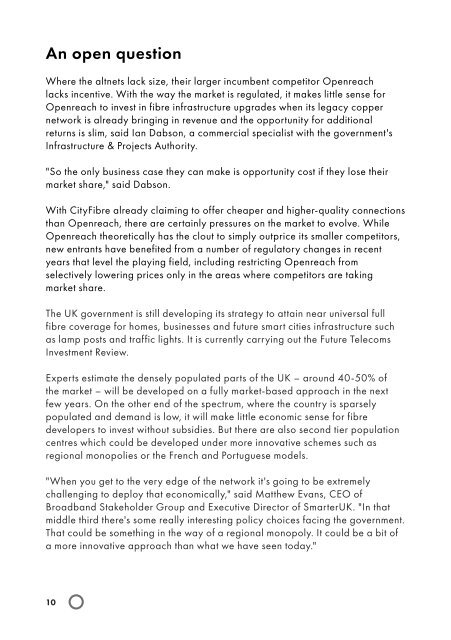Inspiratia InfraTech Takeouts
You also want an ePaper? Increase the reach of your titles
YUMPU automatically turns print PDFs into web optimized ePapers that Google loves.
An open question<br />
Where the altnets lack size, their larger incumbent competitor Openreach<br />
lacks incentive. With the way the market is regulated, it makes little sense for<br />
Openreach to invest in fibre infrastructure upgrades when its legacy copper<br />
network is already bringing in revenue and the opportunity for additional<br />
returns is slim, said Ian Dabson, a commercial specialist with the government's<br />
Infrastructure & Projects Authority.<br />
"So the only business case they can make is opportunity cost if they lose their<br />
market share," said Dabson.<br />
With CityFibre already claiming to offer cheaper and higher-quality connections<br />
than Openreach, there are certainly pressures on the market to evolve. While<br />
Openreach theoretically has the clout to simply outprice its smaller competitors,<br />
new entrants have benefited from a number of regulatory changes in recent<br />
years that level the playing field, including restricting Openreach from<br />
selectively lowering prices only in the areas where competitors are taking<br />
market share.<br />
The UK government is still developing its strategy to attain near universal full<br />
fibre coverage for homes, businesses and future smart cities infrastructure such<br />
as lamp posts and traffic lights. It is currently carrying out the Future Telecoms<br />
Investment Review.<br />
Experts estimate the densely populated parts of the UK – around 40-50% of<br />
the market – will be developed on a fully market-based approach in the next<br />
few years. On the other end of the spectrum, where the country is sparsely<br />
populated and demand is low, it will make little economic sense for fibre<br />
developers to invest without subsidies. But there are also second tier population<br />
centres which could be developed under more innovative schemes such as<br />
regional monopolies or the French and Portuguese models.<br />
"When you get to the very edge of the network it's going to be extremely<br />
challenging to deploy that economically," said Matthew Evans, CEO of<br />
Broadband Stakeholder Group and Executive Director of SmarterUK. "In that<br />
middle third there's some really interesting policy choices facing the government.<br />
That could be something in the way of a regional monopoly. It could be a bit of<br />
a more innovative approach than what we have seen today."<br />
Lessons from France<br />
In a similar vein, the French full fibre market has been developing at a rapid<br />
pace in recent years.<br />
"We started looking at infrastructure in broadband back in 2009," said<br />
Gwenola Chambon, head of infrastructure funds at Mirova. "At the time nobody<br />
was interested in that sector in France. Very limited banks were attracted by the<br />
sector due to technology risk. And then in 2014, we actually went to the capital<br />
markets."<br />
In a few short years, infrastructure investors have come up with ways to compete<br />
with the major telcos, introducing mini-perm structures and creating a new asset<br />
class within rating agencies in order to facilitate aggressively geared project<br />
finance in a space with significant technology and revenue risk. Today, the<br />
market has heated up to the point where some bidders are no longer asking for<br />
subsidies.<br />
"We are in France seeing crazy terms," added Chambon. "We started with an<br />
initial double-digit strategy for new projects and now we are even below double<br />
digits for risky greenfield transactions, because we are facing competition from<br />
incumbents which are just struggling not to lose opportunities."<br />
While the French broadband PPP programme is coming to an end, Chambon<br />
said she sees further opportunities elsewhere in Europe.<br />
"We are in a market that is very hot on infrastructure. There is major potential<br />
for investment. Some of the traditional countries – the UK, Germany, France<br />
and Italy – are lagging behind and we need to catch up and invest massively to<br />
reach the threshold of 80% by 2022."<br />
5G era<br />
Whilst full fibre investment has fallen behind in the UK, authorities are working<br />
to ensure that the nation is at the front of the pack in developing the next major<br />
widely adopted telecom technology – 5G.<br />
The new mobile communications standard is necessary to support many<br />
upcoming innovations – including artificial intelligence, the cloud and driverless<br />
cars – and then connecting these systems to physical infrastructure.<br />
"5G is the bit that sits between the infrastructure and the data and the<br />
10 11


